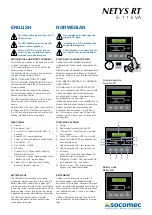
32
1V, check if the wirings are abnormal. If the difference is less than 1v, the output breaker of
the new UPS can be turn on.
8.
Turn on the mains input breakers of all of the UPSs (including the new UPS) and the
battery breaker in the parallel system. After all of the UPSs transfer to the bypass mode,
make sure all maintenance bypass switch are on “BPS” state, then screw the maintenance
cover back again.
9.
Turn on all of the UPS by pressing the “ON” button of each UPS in turn and observe their
LCD display. Observe if all the UPSs transfer to the INV mode at the same time. Measure
the voltage between the JP1 and JP2 on the terminal block of each UPS to check if the
voltage is less than 1V. Or measure the impedance value between JP1 and JP2 to check if
the resistor is short circuited. If the voltage difference is more than 1V, the output relay of
the UPS may have problem and can not be closed.
10. Measure the voltage between JP2s of each UPS (JP2 of Unit I-JP2 of Unit II, and so on) to
check if the voltage value is less than 5V (Generally 2V). If the difference is more than 5V.
You need to check that whether the parallel cable or the parallel board is normal.
11. Measure the inverter output voltage between JP2 and input neutral on each UPS, the
inverter output voltage of each UPS should be as close as possible, if the voltage
difference higher than 1V, please execute a calibration process.
12. Turn off all of the UPS systems that are running. After all of them transfer to the bypass
mode, disassemble the maintenance cover of each UPS and turn the maintenance switch
from “BPS” to “UPS” and screw the maintenance cover right back.
13. Turn on the UPSs and the system work in parallel operation
.
Note:
If the UPS is abnormal in the above process, please perform maintenance according to
the steps of removing single UPS.
















































